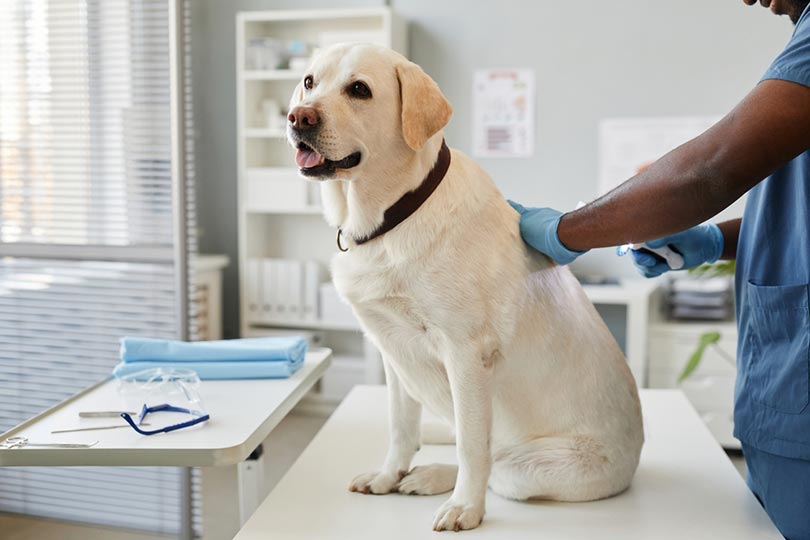Does Pet Insurance Cover Allergy Testing? 2024 Update
Updated on

Owning a pet can be an immensely rewarding experience, but it can also be incredibly expensive. For this reason, more pet owners are beginning to turn to pet insurance to ensure that they can afford unexpected expenses as they crop up. But what if you suspect that your pet might have allergies? Does pet insurance cover allergy testing?
For the most part, as long as the allergies that your pet might be experiencing are not part of a pre-existing condition, most pet insurance companies will cover the cost of allergy testing.
Here, we get into the nitty-gritty of how pet insurance handles allergies and allergy testing so you can better understand what to expect.
A Bit About Seasonal Allergies
Our pets are as prone to allergies as we are. They can have seasonal allergies, and a few of the things that we are allergic to, pets can also be allergic to.
Seasonal or environmental allergies can affect pets from various causes, including but not limited to:
- Fleas and other parasites
- Dander
- Molds
- Dust
- Medications
- Pollen
- Feathers
- Cleaning products
- Fabrics
- Itchy, inflamed skin
- Excessive biting and scratching at the skin
- Facial rubbing and paw licking
- Chronic ear infections
- Increased shedding and hair loss
- Licking the anal area and scooting in dogs
- Respiratory issues
If you suspect that your pet has an environmental allergy, a trip to your vet is in order.
A Bit About Food Allergies

Many pets can develop food allergies. While these kinds of allergies aren’t as common as environmental allergies, they do affect quite a few pets.
Most food allergies are triggered by a protein source and not grains, as many people mistakenly believe. Also, sometimes it’s not an allergy, but rather a food intolerance. Signs that your pet has an issue with their food include gastrointestinal problems like vomiting and diarrhea.
They can also display the allergy with symptoms typically associated with seasonal allergies: itchy skin, ear infections, hair loss, sneezing, and so on.
The most common culprits in food allergies tend to be chicken, beef, and dairy products. Your vet will need to determine if your pet does have a food allergy so it can be treated.
In order to have these procedures covered, it is essential to choose the right pet insurance policy. The best way to choose it is to compare different options on the market. Here are some recommendations of the top-rated insurance companies you can start your comparison with:
Top Rated Pet Insurance Companies:
How Are Environmental Allergies Tested?
There are two methods used to test for environmental allergies, which are RAST and intradermal skin testing.
- RAST or serologic testing: This is essentially just a blood test. The vet draws one blood sample, which is then lab tested for a response to environmental allergens. This is a quick, easy, and affordable method, but the results aren’t quite as accurate as skin testing.
- Intradermal skin testing:This method is similar to the scratch test administered to humans. This is also more uncomfortable for your pet, so they usually need to be sedated for this test. A portion of the animal’s fur is shaved, and multiple allergens are injected under the skin. This technique is more expensive but gives the vet much better results in order to diagnose what is causing your pet’s allergies.
How Are Food Allergies Tested?

This is a longer and trickier process than testing for environmental allergies. The primary way that vets test for food allergies is through the process of elimination. This involves you feeding your pet a hypoallergenic diet for about 8 to 12 weeks. This diet doesn’t include ingredients that your pet has been eating until this point.
The diet features hydrolyzed protein food, which only contains one novel protein (a meat that isn’t as likely to cause allergies, such as duck or venison). If the animal’s symptoms improve and then reappear when given the old food, the vet can make an official diagnosis.
Do Pet Insurance Companies Cover Allergy Testing?
According to Nationwide, the number-one medical condition that brings dogs to the vet is skin allergies. 2022 is the 10th year in a row that skin allergies are the most common health problem for dogs. They were the 10th most common health issue for cats.
Most pet insurance companies cover allergy testing and treatment, which might include the cost of prescription food. However, allergy testing and treatment will only be covered if your pet is being tested for allergies after you’ve already started the coverage. But that’s the case for any health condition.
You also might not receive coverage if your pet has been treated for the common symptoms of allergies, such as ear infections or skin conditions, even if there wasn’t a diagnosis at the time.
If your pet only starts showing allergy symptoms after the insurance policy’s effective date and the waiting period has passed, the allergies could be eligible for coverage.
Does It Cost More?

Whether having allergy testing covered through pet insurance will cost more depends on the company. Some insurance companies will only cover sudden illnesses or accidents, and adding things like routine wellness plans might cost extra.
Other, bigger insurance companies can provide comprehensive plans that include everything from hereditary conditions like hip dysplasia to chronic illnesses like allergies, along with prescription foods and medications.
However, you’ll need to start the insurance before knowing your pet has allergies. Your best bet is to begin the insurance coverage when you first get your puppy or dog, particularly if the breed is prone to skin conditions due to allergies.
Dog Breeds Prone to Allergies
Some dog breeds have more of a genetic predisposition to developing allergies than other breeds:
While these breeds tend to be more inclined to develop allergies, this doesn’t mean they actually will. Almost any dog of any breed, even mixed breeds, can potentially be allergic to something. The average age for a dog to develop allergies is usually between 6 months and 3 years old.
Conclusion
If you plan on bringing a new puppy or dog home, always speak to the breeder about the parents and whether there’s a history of allergies. Also, talk to your vet about the possibility of your dog developing allergies down the road.
If you decide on buying pet insurance but are wondering if it’s worth it, there is no real solid answer here. But if you do decide to go with insurance, the sooner, the better.
Overall, most pet insurance companies cover allergies. Just be sure to read the fine print, or talk to a representative to ensure that you’re receiving the precise coverage for your needs.
Featured Image Credit: Rawpixel.com, Shutterstock












